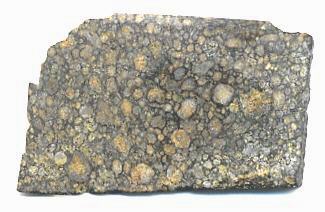LL3.10

Found March 2004
no coordinates recorded A single fusion-crusted stone weighing 1,101 g was found in Kelb Ellouz, Morocco by the French team of Caillou Noir, under the organization of Michel Franco. A portion was sent for analysis to the Museum National d’Histoire Naturelle, France (M. Denise), the Universite Blaise Pascal, France (B. Devouard), and the Université des Sciences et de la Technologie Houari Boumediene, Algeria (M. Messaoudi).
Northwest Africa 4290 was determined to be a highly unequilibrated
ordinary chondriteWork in Progress Ordinary chondrites (OCs) are the largest meteorite clan, comprising approximately 87% of the global collection and 78% of all falls (Meteoritical Society database 2018)1. Meteorites & the Early Solar System: page 581 section 6.1 OC of type 5 or 6 with an apparent shock stage of S1, Click on Term to Read More, and was published as the first known LL3.10
chondriteChondrites are the most common meteorites accounting for ~84% of falls. Chondrites are comprised mostly of Fe- and Mg-bearing silicate minerals (found in both chondrules and fine grained matrix), reduced Fe/Ni metal (found in various states like large blebs, small grains and/or even chondrule rims), and various refractory inclusions (such Click on Term to Read More (NWA 1756 was previously classified as type LL3.0/3.2, but on-going studies have revealed that it is most consistent with type LL3.10). Northwest Africa 4290 has been shocked to stage S3 and has been weathered to grade W3. The
main massLargest fragment of a meteorite, typically at the time of recovery. Meteorites are commonly cut, sliced or sometimes broken thus reducing the size of the main mass and the resulting largest specimen is called the "largest known mass". Click on Term to Read More of NWA 4290 was subsequently purchased by collector S. Turecki, from which the specimen above was derived.
Northwest Africa 4290 is a primitive chondrite, among the very few to have escaped significant
metamorphicRocks that have recrystallized in a solid state due to changes in temperature, pressure, and chemical environment. Click on Term to Read More processes on its parent asteroid. It preserves many primordial features such as the following: 1) a wide range of
olivineGroup of silicate minerals, (Mg,Fe)2SiO4, with the compositional endpoints of forsterite (Mg2SiO4) and fayalite (Fe2SiO4). Olivine is commonly found in all chondrites within both the matrix and chondrules, achondrites including most primitive achondrites and some evolved achondrites, in pallasites as large yellow-green crystals (brown when terrestrialized), in the silicate portion Click on Term to Read More fayalitePure* iron end-member (Fe2SiO4) of the olivine solid solution series and an important mineral in meteorites. When iron (Fe) is completely substituted by magnesium, it yields the the pure Mg-olivine end-member, forsterite (Mg2SiO4). The various Fe and Mg substitutions between these two end-members are described based on their forsteritic (Fo) Click on Term to Read More compositions (Fa0.4–Fa47), and
ferrosiliteA mineral that is composed of Fe-rich pyroxene, FeSiO3. It is the iron endmember of the pyroxene silicate mineral series – enstatite (MgSiO3) to ferrosilite (FeSiO3). Click on Term to Read More compositions (Fs0.7–Fs35); 2) a high
chondruleRoughly spherical aggregate of coarse crystals formed from the rapid cooling and solidification of a melt at ~1400 ° C. Large numbers of chondrules are found in all chondrites except for the CI group of carbonaceous chondrites. Chondrules are typically 0.5-2 mm in diameter and are usually composed of olivine Click on Term to Read More/matrix ratio with 65% Type-II (FeO-rich,
oxidizedOxidation and reduction together are called redox (reduction and oxidation) and generally characterized by the transfer of electrons between chemical species, like molecules, atoms or ions, where one species undergoes oxidation, a loss of electrons, while another species undergoes reduction, a gain of electrons. This transfer of electrons between reactants Click on Term to Read More)
chondrulesRoughly spherical aggregate of coarse crystals formed from the rapid cooling and solidification of a melt at ~1400 ° C. Large numbers of chondrules are found in all chondrites except for the CI group of carbonaceous chondrites. Chondrules are typically 0.5-2 mm in diameter and are usually composed of olivine Click on Term to Read More; 3) well-defined chondrules (0.1 mm to 3 mm, with some up to 10 mm) having dark fine-grained rims; 4) chondrule
mesostasisLast material to crystallize/solidify from a melt. Mesostasis can be found in both chondrules, in the matrix around chondrules, and in achondrites as interstitial fine-grained material such as plagioclase, and/or as glass between crystalline minerals. Click on Term to Read More consists of
isotropicSame in all directions. Click on Term to Read More glass; 5) whereas Cr is rapidly lost from chondrules as metamorphism increases, NWA 4290 contains an average of 0.38 (± 0.21) wt% Cr (in olivines from type-II chondrules).
Recently, a new petrologic scheme was proposed by J. Grossman (2004) and J. Grossman and A. Brearley (2005). It is more discriminating at the lowest petrologic types, those associated with the highly unequilibrated
chondritesChondrites are the most common meteorites accounting for ~84% of falls. Chondrites are comprised mostly of Fe- and Mg-bearing silicate minerals (found in both chondrules and fine grained matrix), reduced Fe/Ni metal (found in various states like large blebs, small grains and/or even chondrule rims), and various refractory inclusions (such Click on Term to Read More (3.0–3.2). This new classification scheme, based on a sensitive technique utilizing the variation in the distribution of Cr in ferroan olivine, is virtually unaffected by the processes of terrestrial weathering and aqueous alteration. The petrologic scale of the new decimal
systemDefinable part of the universe that can be open, closed, or isolated. An open system exchanges both matter and energy with its surroundings. A closed system can only exchange energy with its surroundings; it has walls through which heat can pass. An isolated system cannot exchange energy or matter with has been extended as follows:
3.00–3.05–3.10–3.15–3.2
In subsequent studies of
chromiteBrownish-black oxide of chromium and iron (Cr-Fe oxide), Cr2FeO4, found in many meteorite groups. Click on Term to Read More zoning profiles along with the chromite content of individual ferroan olivine grains, Grossman (2008) was able to further resolve the
petrologic typeMeasure of the degree of aqueous alteration (Types 1 and 2) and thermal metamorphism (Types 3-6) experienced by a chondritic meteorite. Type 3 chondrites are further subdivided into 3.0 through 3.9 subtypes. for chondrites at the lowest metamorphic stages. These two petrographic features provide a reference for a sequencial history of increasing thermal metamorphism that is consistent among olivine grains within each
meteoriteWork in progress. A solid natural object reaching a planet’s surface from interplanetary space. Solid portion of a meteoroid that survives its fall to Earth, or some other body. Meteorites are classified as stony meteorites, iron meteorites, and stony-iron meteorites. These groups are further divided according to their mineralogy and Click on Term to Read More. For metamorphic types 3.00–3.03, chromite zoning profiles are smooth and correlate with igneous FeO zoning profiles. In addition, at this lowest metamorphic stage chromite contents account for 0.3–0.5 wt% in the chondrite groups studied. While chromite contents in type 3.05–3.10 chondrites still reflect the lowest degrees of metamorphism, chromite now exhibits igneous zoning profiles which are no longer smooth. Upon reaching a degree of metamorphism equivalent to type 3.15, chromite zoning has diminished considerably, and chromite abundance is now only 0.1–0.2 wt%. With metamorphic types of at least 3.2, no zoning is observed and chromite abundance is mostly less than 0.1 wt%.
Following the scheme of J. Grossman and A. Brearley (2005), only the
LL chondriteOrdinary chondrites ("low Fe" / "low metal") with only 1 to 3% free metal. Their olivine is more Fe-rich than in the other ordinary chondrites (Fa27-32), implying that the LL types must have formed under more oxidizing conditions than their H or L cousins. Orthopyroxene compositions are also Fe-the rich Click on Term to Read More Semarkona and the
ungroupedModifying term used to describe meteorites that are mineralogically and/or chemically unique and defy classification into the group or sub-group they most closely resemble. Some examples include Ungrouped Achondrite (achondrite-ung), Ungrouped Chondrite (chondrite-ung), Ungrouped Iron (iron-ung), and Ungrouped Carbonaceous (C-ung). Click on Term to Read More (probably CO-related; Simon and Grossman, 2015)
carbonaceous chondriteCarbonaceous chondrites represent the most primitive rock samples of our solar system. This rare (less than 5% of all meteorite falls) class of meteorites are a time capsule from the earliest days in the formation of our solar system. They are divided into the following compositional groups that, other than Click on Term to Read More Acfer 094 (Kimura
et al., 2006) were assigned to the least equilibrated subtype 3.00; however, Semarkona has more recently been determined to represent a petrologic subtype 3.01 (Kimura
et al., 2008). This specific metamorphic type for Semarkona is also consistent with findings based on the FeNi-metal component, the features of which provide one of the most sensitive indicators for the onset of thermal metamorphism. The technique reveals that primary martensite decomposes to fine-grained
plessiteA fine-grained intergrowth of kamacite and taenite that fills in the wedges between wide kamacite and taenite bands in octahedrites. The name derives from the Greek word for "filling." Click on Term to Read More during very low degrees of thermal metamorphism in Semarkona, but which did not occurred in Acfer 094. Furthermore, they found that
metalElement that readily forms cations and has metallic bonds; sometimes said to be similar to a cation in a cloud of electrons. The metals are one of the three groups of elements as distinguished by their ionization and bonding properties, along with the metalloids and nonmetals. A diagonal line drawn Click on Term to Read More in and around Semarkona chondrules does not show a solar ratio of Co/Ni like that in Acfer 094, reflecting the greater degree of metamorphism that affected Semarkona. Moreover, low temperature aqueous alteration has occurred in Semarkona as attested by the presence of secondary alteration products such as smectite.
Another very sensitive method for determining low degrees of metamorphism employs Raman spectra to reveal the maturity of the
matrixFine grained primary and silicate-rich material in chondrites that surrounds chondrules, refractory inclusions (like CAIs), breccia clasts and other constituents. Click on Term to Read More organicPertaining to C-containing compounds. Organic compounds can be formed by both biological and non-biological (abiotic) processes. Click on Term to Read More matter (Bonal
et al., 2006). Results from this technique for NWA 4290 produce values between that of Semarkona (LL3.00) and Bishunpur (L/LL3.15), again consistent with a value of 3.10.
The CO-group meteorite ALHA77307 is consistent with a subtype 3.03, while three ordinary chondrites—QUE 97008, MET 00526, and EET 90161—have been assigned the next lowest petrologic subtype of 3.05. Several meteorites share the less rigorously defined 3.1 subtype. In addition, Kimura
et al. (2008) included the carbonaceous chondrites of groups CR, CH, CB, and CM as probable 3.00 subtype specimens, notwithstanding their current designation of type 2 due to aqueous alteration features. In light of this petrologic typing paradox, they proposed that a separate scale be adopted to describe aqueous alteration which is distinct from the scale currently used for thermal metamorphism.
Further information on the various means of classification of the highly unequilibrated chondrites can be found on the
NWA 1756) page. The photo above shows a 0.692 g very thin partial slice of NWA 4290.







